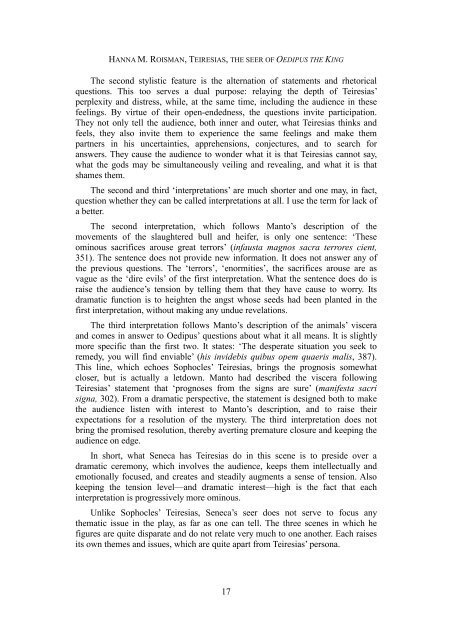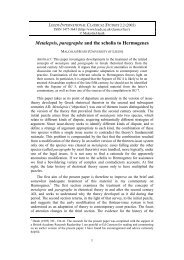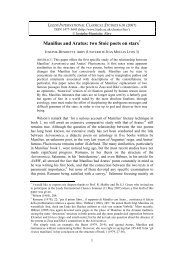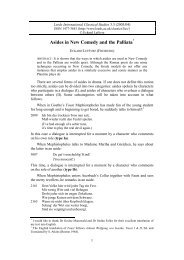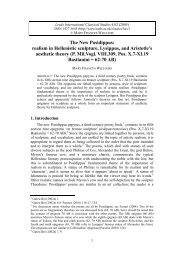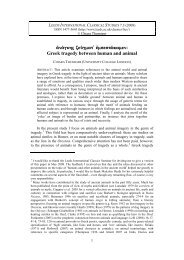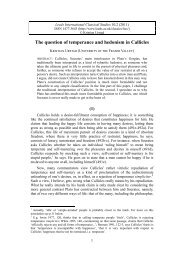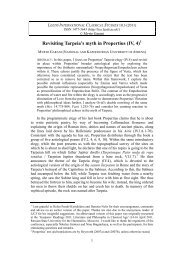Teiresias, the seer of Oedipus the King - Leeds International ...
Teiresias, the seer of Oedipus the King - Leeds International ...
Teiresias, the seer of Oedipus the King - Leeds International ...
You also want an ePaper? Increase the reach of your titles
YUMPU automatically turns print PDFs into web optimized ePapers that Google loves.
HANNA M. ROISMAN, TEIRESIAS, THE SEER OF OEDIPUS THE KING<br />
The second stylistic feature is <strong>the</strong> alternation <strong>of</strong> statements and rhetorical<br />
questions. This too serves a dual purpose: relaying <strong>the</strong> depth <strong>of</strong> <strong>Teiresias</strong>’<br />
perplexity and distress, while, at <strong>the</strong> same time, including <strong>the</strong> audience in <strong>the</strong>se<br />
feelings. By virtue <strong>of</strong> <strong>the</strong>ir open-endedness, <strong>the</strong> questions invite participation.<br />
They not only tell <strong>the</strong> audience, both inner and outer, what <strong>Teiresias</strong> thinks and<br />
feels, <strong>the</strong>y also invite <strong>the</strong>m to experience <strong>the</strong> same feelings and make <strong>the</strong>m<br />
partners in his uncertainties, apprehensions, conjectures, and to search for<br />
answers. They cause <strong>the</strong> audience to wonder what it is that <strong>Teiresias</strong> cannot say,<br />
what <strong>the</strong> gods may be simultaneously veiling and revealing, and what it is that<br />
shames <strong>the</strong>m.<br />
The second and third ‘interpretations’ are much shorter and one may, in fact,<br />
question whe<strong>the</strong>r <strong>the</strong>y can be called interpretations at all. I use <strong>the</strong> term for lack <strong>of</strong><br />
a better.<br />
The second interpretation, which follows Manto’s description <strong>of</strong> <strong>the</strong><br />
movements <strong>of</strong> <strong>the</strong> slaughtered bull and heifer, is only one sentence: ‘These<br />
ominous sacrifices arouse great terrors’ (infausta magnos sacra terrores cient,<br />
351). The sentence does not provide new information. It does not answer any <strong>of</strong><br />
<strong>the</strong> previous questions. The ‘terrors’, ‘enormities’, <strong>the</strong> sacrifices arouse are as<br />
vague as <strong>the</strong> ‘dire evils’ <strong>of</strong> <strong>the</strong> first interpretation. What <strong>the</strong> sentence does do is<br />
raise <strong>the</strong> audience’s tension by telling <strong>the</strong>m that <strong>the</strong>y have cause to worry. Its<br />
dramatic function is to heighten <strong>the</strong> angst whose seeds had been planted in <strong>the</strong><br />
first interpretation, without making any undue revelations.<br />
The third interpretation follows Manto’s description <strong>of</strong> <strong>the</strong> animals’ viscera<br />
and comes in answer to <strong>Oedipus</strong>’ questions about what it all means. It is slightly<br />
more specific than <strong>the</strong> first two. It states: ‘The desperate situation you seek to<br />
remedy, you will find enviable’ (his invidebis quibus opem quaeris malis, 387).<br />
This line, which echoes Sophocles’ <strong>Teiresias</strong>, brings <strong>the</strong> prognosis somewhat<br />
closer, but is actually a letdown. Manto had described <strong>the</strong> viscera following<br />
<strong>Teiresias</strong>’ statement that ‘prognoses from <strong>the</strong> signs are sure’ (manifesta sacri<br />
signa, 302). From a dramatic perspective, <strong>the</strong> statement is designed both to make<br />
<strong>the</strong> audience listen with interest to Manto’s description, and to raise <strong>the</strong>ir<br />
expectations for a resolution <strong>of</strong> <strong>the</strong> mystery. The third interpretation does not<br />
bring <strong>the</strong> promised resolution, <strong>the</strong>reby averting premature closure and keeping <strong>the</strong><br />
audience on edge.<br />
In short, what Seneca has <strong>Teiresias</strong> do in this scene is to preside over a<br />
dramatic ceremony, which involves <strong>the</strong> audience, keeps <strong>the</strong>m intellectually and<br />
emotionally focused, and creates and steadily augments a sense <strong>of</strong> tension. Also<br />
keeping <strong>the</strong> tension level—and dramatic interest—high is <strong>the</strong> fact that each<br />
interpretation is progressively more ominous.<br />
Unlike Sophocles’ <strong>Teiresias</strong>, Seneca’s <strong>seer</strong> does not serve to focus any<br />
<strong>the</strong>matic issue in <strong>the</strong> play, as far as one can tell. The three scenes in which he<br />
figures are quite disparate and do not relate very much to one ano<strong>the</strong>r. Each raises<br />
its own <strong>the</strong>mes and issues, which are quite apart from <strong>Teiresias</strong>’ persona.<br />
17


